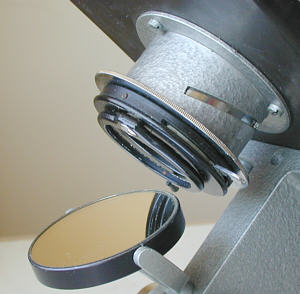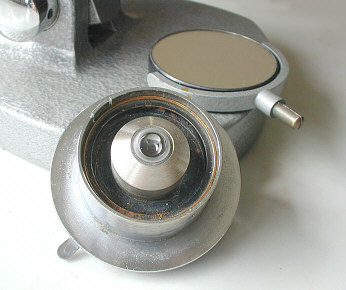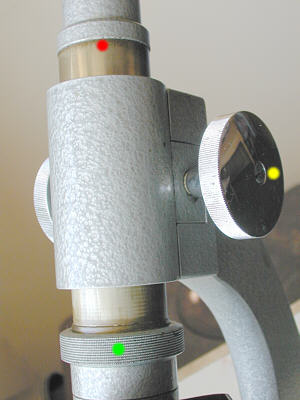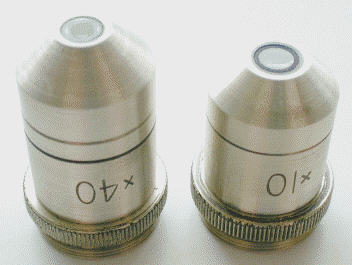|
A look at an older 'scope used in schools By Paul James (uk)
|
|
A look at an older 'scope used in schools By Paul James (uk)
|
General mechanical features
The images show a simple yet solid stand with grey speckle finish and weighing in at just over 3 kilo's, so though it is no heavyweight, it is solid and stable enough, yet not too difficult for young students to handle from case to benchtop. It's simplicity belies its mechanical quality, and apart from some minor niggles, which have more to do with its age than design faults, the stand is very well made. It is clearly a simple yet reliable instrument made for use in schools, and the fact that it has survived about 25 years in this environment is evidence of good design and manufacture.
A plain foot is used which is very compact and neat, which holds two adjustable screws set to control the limb's vertical and horizontal extremes. The 'pin' holding it to the limb is solid yet easily adjusted to control friction.
Simple elegance would be the way I'd describe the limb with its nice sweep, affording uncomplicated handling which is important in a school environment, where safe passage across the lab is essential!
Composite material is used for the stage which has stood the test of time too, and is still at right angles to the axis! The two stage clips show understandable wear and tear, but they were easily brought back to their original state.
Substage
 |
The iris is accurately centred, but I found difficulty in locating its operating lever since that depended on the setting of the condenser's focus, which in turn varied its peripheral position by up to about about 60-70 degrees, owing to its helix mounting. Not the sort of feature a child could automatically compensate for easily, let alone an adult used to operating microscopes.
 |
Focussing mechanisms
 |
The fine focus is unusual in that the lower end of the 'draw' tube can be raised or lowered by rotating a knurled ring. In this example it was heavily greased which reduced its sensitivity, but was easily remedied. It was at this juncture that I realised the general engineering of the microscope was of a very good standard. Finding this knurled ring whilst peeping through the eyepiece took some getting used to as my hand was searching for a more conventional control.
The Optics
I was impressed by the optical quality of this microscope. Even on difficult subject matter, the images were easily mistaken for those from standard biological instruments. Uniformity of the illuminated field was good on all powers and showed fairly good resolution right across it. The 0.7NA x40's performance was in excess of what would have been required from its use in schools, and the 0.25NA x10 also. Field flatness was also good, using the x10 Huygens eyepiece provided, though eye relief was minimal. The third objective was missing, so I have placed a x3 Baker optic there which is nearly parfocal with the other two and complements them satisfactorily.
 |
|
|
Although only one x10 Huygenian eyepiece came with this instrument, its case showed evidence of homes for 2 more. All together a tidy optical outfit.
Conclusion
Despite a couple of
minor niggles, which could be easily remedied, this instrument remains
a well conceived and engineered example of that class of microscope which
could be found in large numbers in schools in the UK about 25 years back.
Coupled with the mechanical stage, which was missing, this microscope would
have been certainly capable of keeping a keen student of biology busy for
a number of years. This model is anything but a toy...........my apologies
'Britex' !
| All comments to the author Paul James are welcomed |
© Microscopy UK or their
contributors.
Published in the June 2003
edition of Micscape Magazine.
Please report any Web problems or offer general comments to the Micscape Editor.